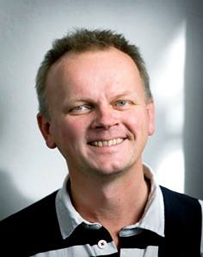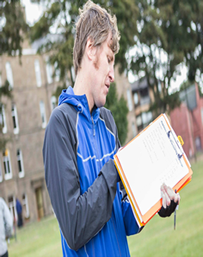Jan Gulliksen 
Short Bio: Jan Gulliksen is a professor in Human Computer interaction at KTH – the Royal Institute of Technology, Stockholm, Sweden. He is also the Dean of the School of Computer Science and communication. Jan was recently appointed as chairman of the digital commission of Sweden's government, department of enterprise and is also appointed as the Digital champion of Sweden by the European commission. He is the chairman of IFIP TC 13 on HCI, chairman of the NordiCHI collaboration and founder of the NordiCHI conference series. Jan has conducted a number of larger Action Research projects with the purpose of increasing the usability by introducing new user-centred design methodologies at several public authorities. He has authored more than 100 publications on these matters.
Human Computer Interaction and societal impact – Can HCI influence public policy making and IT politics?
Abstract: Research and research funding organizations are becoming more and more aware of the need to conduct research that proves some form of utility to the society and has some form of practical impact. There are several different ways of making research that has practical relevance and that can contribute to changing and improving society. This talk aims at discussing ways to plan, conduct research with the aim of improving the society and also show how we should make use of our research knowledge and positions to influence politics and public policy making.
Sarah Horton 
Short Bio: Sarah Horton started her career in interaction design in 1991 at the Yale Center for Advanced Instructional Media, creating award-winning interactive instructional software. She was an instructional technologist at Dartmouth College for 11 years before becoming Director of Web Strategy and Design. In this role, she was responsible for planning and developing Dartmouth’s digital environment, leading a team of user-experience professionals responsible for web and media design, development, and production. More recently, Sarah was Web Strategy Project Lead at Harvard University, responsible for strategy and user experience design for the Harvard Web Publishing Initiative. Sarah is currently Director of Accessible User Experience for The Paciello Group. He is the co-author with Patrick Lynch of Web Style Guide, now in its third edition and translated into more than eight languages. She also wrote Web Teaching Guide, which won the American Association of Publishers award for the Best Book in Computer Science in 2000. Her third book, Access by Design, combines the disciplines of universal design, accessibility, and usability into guidelines for designing websites that are universally usable. Sarah's latest book, A Web for Everyone: Designing Accessible User Experiences with Whitney Quesenbery, was published in 2014 by Rosenfeld Media.
Sarah's publication and presentation credits also include the New York Times, Peachpit, and Digital Web Magazine, and the International Cross-Disciplinary Workshop on Web Accessibility (W4A), WebVisions, World Usability Day, UXPA, and the Human-Computer Interaction Laboratory Annual Symposium. She has been member of the Web Accessibility Initiative, and consulted for the Dartmouth Hitchcock Medical Center and the World Health Organization.
David Sloan 
Short Bio: David Sloan joined The Paciello Group (TPG) in May 2013, to help develop the company’s Accessible User Experience service. In his role, he focuses on advising and supporting organizations in industry, government and education on strategy and activity in developing and implementing Accessible UX.
Previously, he spent over 13 years at the School of Computing, in the University of Dundee, Scotland, as a researcher, lecturer and consultant specializing in inclusive design and accessibility. In 1999, he helped set up the Digital Media Access Group, one of the world’s first web accessibility consultancies, and pioneered a mixed-method approach to accessibility evaluation, combining manual and automated inspection methods with usability evaluations with people with disabilities. He also set up and co-ordinated the University’s Web Accessibility Support Service, working with web developers, learning technologists and disability support staff to advocate and support greater awareness and adoption of accessibility across campus.
During his time at the University of Dundee, David completed a PhD investigating the effectiveness of the web accessibility audit as a motivational and educational tool. He was also involved in a number of research projects investigating topics such as producing an educational resource on creating accessible multimedia for teaching and learning, sustaining independent use of IT amongst older adults, cognitive modeling of older adults’ browsing behavior, and investigating user-centered design applied to scientific software development.
He taught undergraduate and postgraduate courses in web design, HCI and inclusive design, and supervised several accessibility-related student projects. He was also active in staff development education activities, teaching web design and accessible e-learning experience design.
David has spoken on matters relating to digital accessibility at academic and industry conferences around the world, and was an invited keynote speaker at the Accessing Higher Ground conference in Denver in 2013. He is a member of the Steering Committee of W4A, the annual International Web for All conference, having served as Program Chair of W4A 2008 and General Chair of W4A 2009. He maintains his ties with academia as an active journal paper reviewer and PhD examiner.
Previously, he worked as a digital cartographer for HarperCollins Cartographic, now Collins Bartholomew, developing digital geographic datasets for the generation of sheet maps and world atlases.
Accessibility Designing for People
Sarah Horton and David Sloan
What if we focused on people with disabilities when thinking about designing for people? What if we didn’t treat accessibility as a binary, but rather a continuum, where small steps forward count as progress? What if we integrated accessibility into current computer science and design education rather than treating it as a separate topic? What if there were no such thing as accessibility—only good design, and good practice?
We are accessible user experience consultants for a US-based accessibility consultancy, The Paciello Group. We work with organizations across sectors, including Google, Pearson, Healthwise, and Stanford University, to improve product accessibility and integrate best practices into organizational culture and practice. This exposure to diverse products and practices has enabled us to see firsthand the challenges organizations face in achieving and sustaining accessibility.
In the course of our work we have come to realize that the current approach to accessibility is not working. Accessibility is considered its own entity, assigned to one person or to a consultant to resolve. It is addressed at the end of the product lifecycle, when changes are difficult and costly to implement. People with disabilities are not included in user research activities and their perspective does not inform design decisions. At the same time, obligations around access to digital technologies for people with disabilities are becoming more defined, and organizations are struggling to retrofit existing products for compliance. All the while, web and software development practices are evolving and increasing in complexity to keep pace with technology change. It is no wonder that accessibility is seen as something burdensome that stifles creativity, disrupts project progress, and whose benefits are experienced by only a small number of people.
Yet we also know that inclusivity has wide-reaching benefits. We know that including people with disabilities, in our homes, schools, and communities, benefits everyone. We know that addressing the needs of people with disabilities through design results in environments, products, and services that work better for everyone. We know that the attention to detail and structural integrity required for digital accessibility leads to more stable and sustainable technologies.
We must change how we approach accessibility and take advantage of the benefits of inclusivity. It’s time we turn the tables on current approaches to accessibility and make accessibility simply designing for people.
In our talk we will share our views on how Accessible User Experience (AUX) can help us transition from Accessibility and User Experience as separate disciplines to where including people with disabilities is done as a matter of course, as a fundamental aspect of design and development activities. To get there we must inspire and encourage change in the way digital products and services are conceived of, designed, and implemented. We must influence how digital content creators and consumers understand how technology supports the diverse needs of people. Underlying these efforts must be a shared understanding that access to digital products and services is a fundamental human right. From that starting point we can take responsibility for ensuring that our creative use of technology as an innovation—as a means to provide information and services—provides inclusion rather than exclusion for people with disabilities.
Academia and industry share responsibility in achieving these milestones. We look forward to engaging with conference delegates to discuss how we can work together to make accessibility a given in any technology project.
| Hosted by | Promoted by | Sponsored by | Supported by |

|

|

|

|